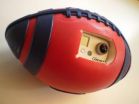(Press-News.org) A look at how the brain processes information finds a distinct pattern in children with autism spectrum disorders. Using EEGs to track the brain's electrical cross-talk, researchers from Boston Children's Hospital have found a structural difference in brain connections. Compared with neurotypical children, those with autism have multiple redundant connections between neighboring brain areas at the expense of long-distance links.
The study, using a "network analysis" like that used to study airlines or electrical grids, may help in understanding some classic behaviors in autism. It was published February 27 in BioMed Central's open access journal BMC Medicine, accompanied by a commentary.
"We examined brain networks as a whole in terms of their capacity to transfer and process information," says Jurriaan Peters, MD, of the Department of Neurology at Boston Children's Hospital, who is co-first author of the paper with Maxime Taquet, a PhD student in Boston Children's Computational Radiology Laboratory. "What we found may well change the way we look at the brains of autistic children."
Peters, Taquet and senior authors Simon Warfield, PhD, of the Computational Radiology Laboratory and Mustafa Sahin, MD, PhD, of Neurology, analyzed EEG recordings from two groups of autistic children: 16 children with classic autism, and 14 children whose autism is part of a genetic syndrome known as tuberous sclerosis complex (TSC). They compared these readings with EEGs from two control groups—46 healthy neurotypical children and 29 children with TSC but not autism.
In both groups with autism, there were more short-range connections within different brain region, but fewer connections linking far-flung areas.
A brain network that favors short-range over long-range connections seems to be consistent with autism's classic cognitive profile—a child who excels at specific, focused tasks like memorizing streets, but who cannot integrate information across different brain areas into higher-order concepts.
"For example, a child with autism may not understand why a face looks really angry, because his visual brain centers and emotional brain centers have less cross-talk," Peters says. "The brain cannot integrate these areas. It's doing a lot with the information locally, but it's not sending it out to the rest of the brain."
Network analysis—a hot emerging branch of cognitive neuroscience—showed a quality called "resilience" in the children with autism—the ability to find multiple ways to get from point A to point B through redundant pathways.
"Much like you can still travel from Boston to Brussels even if London Heathrow is shut down, by going through New York's JFK airport for example, information can continue to be transferred between two regions of the brain of children with autism," says Taquet. "In such a network, no hub plays a specific role, and traffic may flow along many redundant routes."
This quality of redundancy is consistent with cellular and molecular evidence for decreased "pruning" of brain connections in autism. While it may be good for an airline, it may indicate a brain that responds in the same way to many different kinds of situations and is less able to focus on the stimuli that are most important.
"It's a simpler, less specialized network that's more rigid, less able to respond to stimulation from the environment," says Peters.
The study showed that both groups of children with tuberous sclerosis complex had reduced connectivity overall, but only those who also had autism had the pattern of increased short-range versus long-range connections (See image).
Under a recently announced NIH Autism Center of Excellence Grant, Peters and his colleagues will repeat the analysis as part of a multicenter study, taking EEG recordings prospectively under uniform conditions.
The current study builds on recent work by Peters, Sahin and colleagues, which imaged nerve fibers in autistic patients and showed structural abnormalities in brain connectivity. Other recent work at Boston Children's, led by Frank Duffy, PhD, of Neurology, looked at "coherence," or the degree of synchrony between any two given EEG signals, and found altered connectivity between brain regions in children with autism.
Yet another recent study, led by Boston Children's informatics researcher William Bosl, PhD, and Charles A. Nelson, PhD, research director of the Developmental Medicine Center, looked at the degree of randomness in EEG signals, an indirect indicator of connectivity, and found patterns that distinguished infants at increased risk for autism from controls.
###
The current study was funded by the National Institutes of Health (grant #s R01 RR021885, R01 LM010033, R03 EB008680, UL1 RR025758 to Warfield; P20 RFA-NS-12-006, 1U01NS082320-01 to Sahin and Peters); the National Institute of Mental Health (grant #K23MH094517 to coauthor Shafali Jeste); the National Institute on Deafness and Other Communication Disorders (grant #DC 10290 to Charles Nelson, PhD) and the Department of Defense (grant #W81XWH-11-1-0365 to Nelson).
Boston Children's Hospital is home to the world's largest research enterprise based at a pediatric medical center, where its discoveries have benefited both children and adults since 1869. More than 1,100 scientists, including nine members of the National Academy of Sciences, 11 members of the Institute of Medicine and 12 members of the Howard Hughes Medical Institute comprise Boston Children's research community. Founded as a 20-bed hospital for children, Boston Children's today is a 395-bed comprehensive center for pediatric and adolescent health care grounded in the values of excellence in patient care and sensitivity to the complex needs and diversity of children and families. Boston Children's also is a teaching affiliate of Harvard Medical School. For more information about research and clinical innovation at Boston Children's, visit: http://vectorblog.org/.
END
A researcher from North Carolina State University has developed a technique for creating high-density ceramic materials that requires far lower temperatures than current techniques – and takes less than a second, as opposed to hours. Ceramics are used in a wide variety of technologies, including body armor, fuel cells, spark plugs, nuclear rods and superconductors.
At issue is a process known as "sintering," which is when ceramic powders (such as zirconia) are compressed into a desired shape and exposed to high heat until the powder particles are bound together into a ...
(27 February 2013) Although considerable progress has been made in determining the impact of the gut microbiota on the development of inflammatory bowel disease (IBD) and other gastrointestinal (GI) diseases, the detailed study and understanding of the composition and effects of this intestinal community still faces numerous methodological and empirical challenges.
"Improvement of study design and sample collection, as well as a more precise understanding of the various genetic and environmental influences, are asked for," says Professor Dirk Haller (Technical University ...
Two new species of the gorgonian inhabiting barnacles — Conopea saotomensis and Conopea fidelis — have been collected from the area surrounding the historically isolated volcanic islands of São Tomé and Príncipe. The barnacles of this genus are widely spread across the temperate and tropical oceans, but what makes them special is that they occur exclusively in a symbiotic relationship with a gorgonian or black coral hosts. Observations suggest that the barnacles might have a unique ability to recognize and choose a specific host of their preference. The study was published ...
Washington, DC, February 27, 2013 -- Patients who tested positive for carbapenem-resistant Enterobacteriaceae (CRE) took an average of 387 days following hospital discharge to be clear of the organism, according to a new study published in the March issue of the American Journal of Infection Control, the official publication of the Association for Professionals in Infection Control and Epidemiology (APIC).
The study was conducted in the Shaare Zedek Medical Center, a 700-bed university-affiliated general hospital in Jerusalem, Israel. The research team analyzed follow-up ...
According to a recent University of Eastern Finland (UEF) study, elevated cell sugar concentrations increase the production of hyaluronan which, in turn, promotes cancer growth. Regulating the production of hyaluronan may be a way to prevent the spreading of cancer.
Hyaluronan is a long, linear carbohydrate polymer present in the human body. It forms a coating on the surface of many cells and plays a key role in fetal development and in the maintenance of normal tissue balance.
Under normal circumstances, hyaluronan promotes tissue healing; however, it can also maintain ...
Millions of tons of food are thrown away each year because the 'best before' date has passed. But this date is always a cautious estimate, which means a lot of still-edible food is thrown away. Wouldn't it be handy if the packaging could 'test' whether the contents are still safe to eat? Researchers at Eindhoven University of Technology, Universitá di Catania, CEA-Liten and STMicroelectronics have invented a circuit that makes this possible: a plastic analog–digital converter. This development brings plastic sensor circuits costing less than one euro cent within reach. ...
Scientists are reporting "laboratory resurrections" of several 2-3-billion-year-old proteins that are ancient ancestors of the enzymes that enable today's antibiotic-resistant bacteria to shrug off huge doses of penicillins, cephalosporins and other modern drugs. The achievement, reported in the Journal of the American Chemical Society, opens the door to a scientific "replay" of the evolution of antibiotic resistance with an eye to finding new ways to cope with the problem.
Jose M. Sanchez-Ruiz, Eric A. Gaucher, Valeria A. Risso and colleagues explain that antibiotic ...
Scientists at the University of Southampton have taken a significant and important step in keeping people safe from the most common form of meningitis in the UK.
Meningitis B (also known as Meningococcal group B or MenB) is one of the deadliest strains of meningitis. Each year, an average of 1,870 people in the UK are affected by the disease with one in 10 people dying from it.
Recently the first potentially universal MenB vaccine was awarded a license for use throughout Europe, but it has been estimated that in this country, this new vaccine should protect against ...
PITTSBURGH—Football fans have become accustomed to viewing televised games from a dozen or more camera angles, but researchers at Carnegie Mellon University and the University of Electro-Communications (UEC) in Tokyo suggest another possible camera position: inside the ball itself.
The researchers have shown that a camera embedded in the side of a rubber-sheathed plastic foam football can record video while the ball is in flight that could give spectators a unique, ball's-eye view of the playing field. Because a football can spin at 600 rpm, the raw video is an unwatchable ...
In an advance toward glass that remains clear under the harshest of conditions, scientists are reporting development of a new water-repellant coating that resists both fogging and frosting. Their research on the coating, which could have uses ranging from automobile windshields to camera lenses, appears in the journal ACS Nano.
Michael F. Rubner, Robert E. Cohen and colleagues point out that anti-fogging coatings that absorb water have been the focus of attention lately because of their ability to reduce light scattering and the resultant distortion caused by condensation. ...



